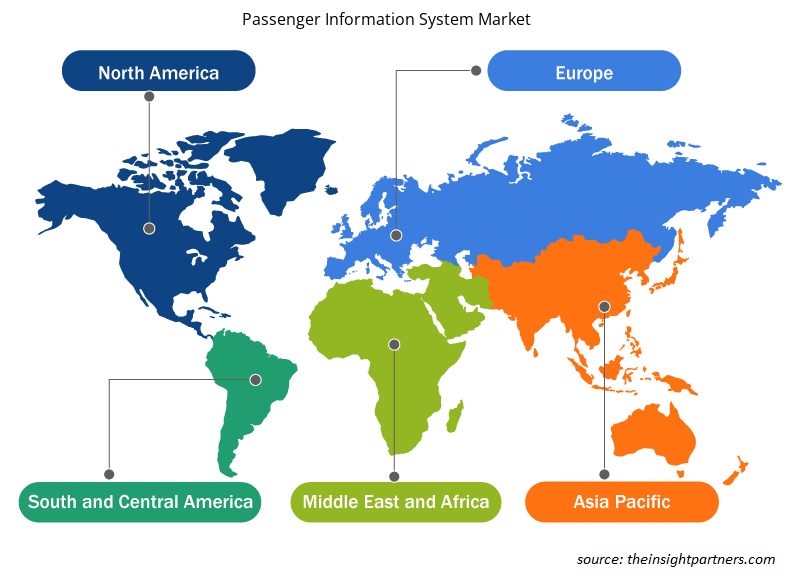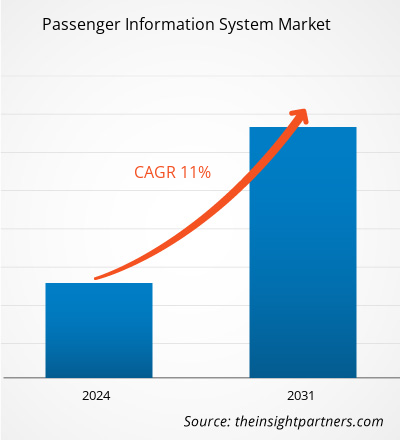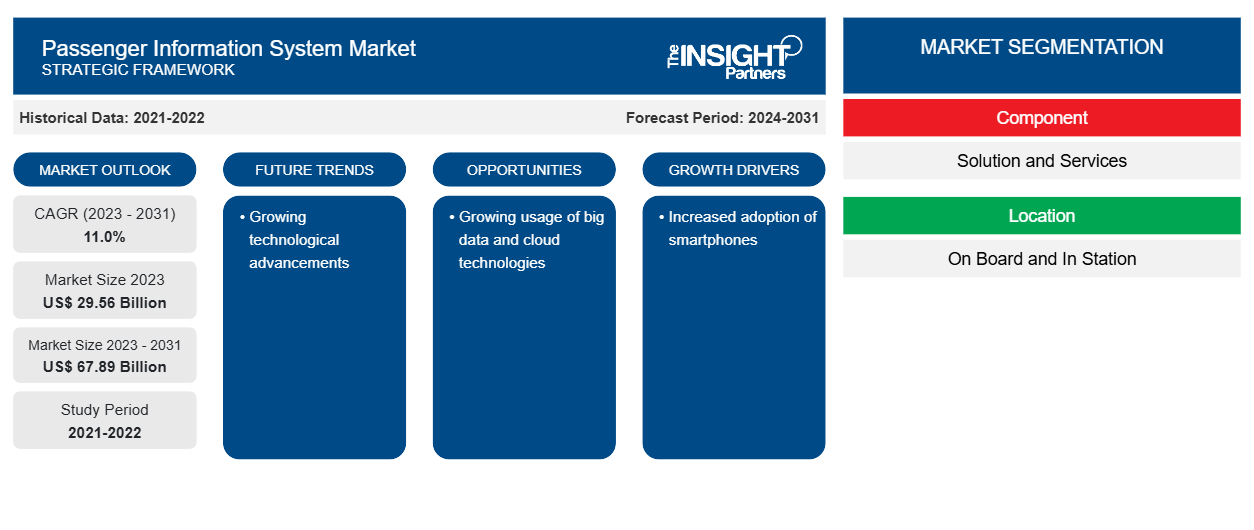Si prevede che la dimensione del mercato del sistema informativo per i passeggeri raggiungerà i 67,89 miliardi di dollari entro il 2031, rispetto ai 29,56 miliardi di dollari del 2023. Si prevede che il mercato registrerà un CAGR dell'11,0% nel 2023-2031. È probabile che i crescenti progressi tecnologici rimangano tendenze chiave del mercato del sistema informativo per i passeggeri.
Analisi di mercato del sistema informativo per i passeggeri
La domanda di sistemi di informazione per i passeggeri è cresciuta a causa di diversi fattori, tra cui un aumento del traffico aereo, un aumento nell'adozione di sistemi di trasporto intelligenti, un aumento della penetrazione di soluzioni IoT nel settore dei trasporti e un aumento della domanda di informazioni sui trasporti in tempo reale da parte dei passeggeri. Inoltre, si prevede che il mercato dei sistemi di informazione per i passeggeri trarrà vantaggio dall'aumento della domanda di tutte le informazioni relative ai viaggi, dai pianificatori di viaggio alle variazioni negli orari di partenza previsti. Inoltre, si prevede che una maggiore consapevolezza tra le agenzie di trasporto nel fornire ai clienti un'esperienza di viaggio migliore stimolerà l'espansione del mercato.
Panoramica del mercato dei sistemi informativi per i passeggeri
Lo scopo di un sistema informativo per i passeggeri è quello di fornire ai passeggeri informazioni aggiornate tramite dispositivi audio , video e multimediali sulle condizioni e sul tipo di servizi di trasporto. È costituito da una raccolta di componenti hardware e IT. Fornisce inoltre servizi di notizie e intrattenimento, nonché dettagli sull'orario previsto di arrivo e partenza, tutti elementi che contribuiscono a migliorare l'esperienza di viaggio. Il mercato dei sistemi informativi per i passeggeri si sta espandendo a causa della crescente necessità delle agenzie di trasporto di fornire ai passeggeri informazioni accurate e affidabili in tempo reale sui trasporti. Inoltre, il mercato si sta espandendo a causa degli sviluppi nel settore delle telecomunicazioni che consentono capacità di trasferimento dati più rapide, un'impennata nell'adozione dell'IoT nel settore dei trasporti e un aumento della domanda di sistemi di trasporto intelligenti.
Personalizza questo report in base alle tue esigenze
Riceverai la personalizzazione gratuita di qualsiasi report, comprese parti di questo report, o analisi a livello nazionale, pacchetto dati Excel, oltre a usufruire di grandi offerte e sconti per start-up e università
-
Scopri le principali tendenze di mercato in questo rapporto.Questo campione GRATUITO includerà analisi di dati che spaziano dalle tendenze di mercato alle stime e alle previsioni.
Driver e opportunità del mercato dei sistemi informativi per i passeggeri
Maggiore adozione degli smartphone
Poiché l'uso degli smartphone è in aumento, i sistemi di informazione per i passeggeri basati su applicazioni mobili stanno rapidamente guadagnando popolarità. Inoltre, le agenzie di trasporto si stanno concentrando sulle applicazioni mobili dei sistemi di informazione per i passeggeri per attrarre i clienti e dare loro accesso a informazioni rapide, accurate e in tempo reale tramite i canali degli smartphone. Inoltre, l'aumento delle applicazioni di transito multimodale per il trasporto pubblico presenta un'opportunità di espansione del mercato.
Crescente utilizzo di big data e tecnologie cloud
Le ferrovie, in particolare, stanno utilizzando il cloud computing per automatizzare molte forme di trasporto. Utilizzando la tecnologia del cloud computing, il sistema informativo per i passeggeri traccia la posizione degli autobus nelle vicinanze. Determina l'orario di arrivo, che viene poi mostrato sul sistema informativo in tempo reale alla fermata dell'autobus. L'utilizzo della tecnologia cloud e delle soluzioni di analisi dei dati contribuisce all'allocazione efficiente delle risorse e al monitoraggio economico della popolazione di passeggeri.
Analisi della segmentazione del rapporto di mercato del sistema informativo per i passeggeri
I segmenti chiave che hanno contribuito alla derivazione dell'analisi di mercato del sistema informativo per i passeggeri sono: componente, ubicazione, modalità di trasporto e modello funzionale.
- In base al componente, il mercato dei sistemi informativi per i passeggeri è suddiviso in soluzioni e servizi. Il segmento delle soluzioni ha detenuto una quota di mercato maggiore nel 2023.
- In base alla posizione, il mercato è segmentato in on-board e in-station. Il segmento on-board ha detenuto la quota maggiore del mercato nel 2023.
- In termini di modalità di trasporto, il mercato è diviso in strade, ferrovie, vie d'acqua e vie aeree. Il segmento delle strade ha dominato il mercato nel 2023.
- In base al modello funzionale, il mercato è segmentato in display multimediali, sistemi audio, sistemi informatici, dispositivi di rete e comunicazione, videosorveglianza e sistemi di gestione dei contenuti.
Analisi della quota di mercato del sistema informativo per passeggeri per area geografica
L'ambito geografico del rapporto di mercato sui sistemi informativi per i passeggeri è principalmente suddiviso in cinque regioni: Nord America, Asia Pacifico, Europa, Medio Oriente e Africa e Sud America/Sud e Centro America. Il Nord America controlla il mercato globale dei sistemi informativi per i passeggeri. Inoltre, durante il periodo previsto, il mercato nordamericano probabilmente aumenterà a un ritmo elevato. Il fattore principale che guida l'espansione del mercato in quest'area è l'aumento sia della produzione che del consumo di sistemi informativi per i passeggeri nelle economie sviluppate e in via di sviluppo del Nord America. Il PIS è considerato uno dei mercati più grandi, con un utilizzo notevolmente elevato di tecnologie all'avanguardia e una solida infrastruttura di rete. L'area ha un impatto significativo sull'espansione del mercato dei sistemi informativi per i passeggeri a causa di elementi tra cui l'aumento dell'uso del trasporto pubblico e il ritmo rapido dell'urbanizzazione. Inoltre, si prevede che il crescente utilizzo di servizi e soluzioni di sistemi informativi per i passeggeri favorirà la sua espansione. Tutti questi fattori contribuiscono alla crescita del mercato dei sistemi informativi per i passeggeri nella regione.
Approfondimenti regionali sul mercato dei sistemi informativi per i passeggeri
Le tendenze regionali e i fattori che influenzano il mercato dei sistemi informativi per i passeggeri durante il periodo di previsione sono stati ampiamente spiegati dagli analisti di Insight Partners. Questa sezione discute anche i segmenti e la geografia del mercato dei sistemi informativi per i passeggeri in Nord America, Europa, Asia Pacifico, Medio Oriente e Africa e Sud e Centro America.

- Ottieni i dati specifici regionali per il mercato del sistema informativo passeggeri
Ambito del rapporto di mercato sul sistema informativo per i passeggeri
| Attributo del report | Dettagli |
|---|---|
| Dimensioni del mercato nel 2023 | 29,56 miliardi di dollari USA |
| Dimensioni del mercato entro il 2031 | 67,89 miliardi di dollari USA |
| CAGR globale (2023-2031) | 11,0% |
| Dati storici | 2021-2022 |
| Periodo di previsione | 2024-2031 |
| Segmenti coperti |
Per componente
|
| Regioni e Paesi coperti |
America del Nord
|
| Leader di mercato e profili aziendali chiave |
|
Densità degli attori del mercato: comprendere il suo impatto sulle dinamiche aziendali
Il mercato del Passenger Information System Market sta crescendo rapidamente, spinto dalla crescente domanda degli utenti finali dovuta a fattori quali l'evoluzione delle preferenze dei consumatori, i progressi tecnologici e una maggiore consapevolezza dei vantaggi del prodotto. Con l'aumento della domanda, le aziende stanno ampliando le loro offerte, innovando per soddisfare le esigenze dei consumatori e capitalizzando sulle tendenze emergenti, il che alimenta ulteriormente la crescita del mercato.
La densità degli operatori di mercato si riferisce alla distribuzione di aziende o società che operano in un particolare mercato o settore. Indica quanti concorrenti (operatori di mercato) sono presenti in un dato spazio di mercato in relazione alle sue dimensioni o al valore di mercato totale.
Le principali aziende che operano nel mercato dei sistemi informativi per i passeggeri sono:
- CORPORAZIONE TELESTE
- SIEMENS AG
- GRUPPO TALES
- CORPORAZIONE CUBICA
- INDRA SISTEMAS SA
- ALSTOM
Disclaimer : le aziende elencate sopra non sono classificate secondo un ordine particolare.

- Ottieni una panoramica dei principali attori del mercato dei sistemi informativi per i passeggeri
Notizie di mercato e sviluppi recenti del sistema informativo per i passeggeri
Il mercato dei sistemi informativi per i passeggeri viene valutato raccogliendo dati qualitativi e quantitativi dopo la ricerca primaria e secondaria, che include importanti pubblicazioni aziendali, dati associativi e database. Di seguito è riportato un elenco degli sviluppi nel mercato:
- A gennaio 2021, per ampliare il suo attuale portafoglio di tecnologie di trasporto, Cubic Corporation ha introdotto la suite di piattaforme completamente integrate "UMO" per mobilità, passeggeri, fornitori di servizi e autorità di transito. UMO è una suite flessibile di strumenti che consente agli utenti di pianificare viaggi sia sui trasporti pubblici che privati, pagarli, ottenere premi per i viaggi e ricevere informazioni aggiornate per aumentare la loro mobilità.
(Fonte: Cubic Corporation, sito web aziendale)
- A giugno 2020, Wabtec Corporation ha introdotto il dispositivo di filtraggio dell'aria "BlueFiIter" per offrire ai passeggeri di treni e metropolitane un ambiente pulito e salutare. Nei vagoni ferroviari, BlueFilter elimina oltre il 90% dei contaminanti.
(Fonte: Wabtec Corporation, sito web aziendale)
Copertura e risultati del rapporto di mercato sul sistema informativo per i passeggeri
Il rapporto "Dimensioni e previsioni del mercato dei sistemi informativi per i passeggeri (2021-2031)" fornisce un'analisi dettagliata del mercato che copre le seguenti aree:
- Dimensioni e previsioni del mercato a livello globale, regionale e nazionale per tutti i segmenti di mercato chiave coperti dall'ambito
- Dinamiche di mercato come fattori trainanti, vincoli e opportunità chiave
- Principali tendenze future
- Analisi dettagliata delle cinque forze PEST/Porter e SWOT
- Analisi di mercato globale e regionale che copre le principali tendenze di mercato, i principali attori, le normative e gli sviluppi recenti del mercato
- Analisi del panorama industriale e della concorrenza che copre la concentrazione del mercato, l'analisi della mappa di calore, i principali attori e gli sviluppi recenti
- Profili aziendali dettagliati
- Analisi storica (2 anni), anno base, previsione (7 anni) con CAGR
- Analisi PEST e SWOT
- Valore/volume delle dimensioni del mercato - Globale, Regionale, Nazionale
- Industria e panorama competitivo
- Set di dati Excel
Report recenti
Testimonianze
Motivo dell'acquisto
- Processo decisionale informato
- Comprensione delle dinamiche di mercato
- Analisi competitiva
- Analisi dei clienti
- Previsioni di mercato
- Mitigazione del rischio
- Pianificazione strategica
- Giustificazione degli investimenti
- Identificazione dei mercati emergenti
- Miglioramento delle strategie di marketing
- Aumento dell'efficienza operativa
- Allineamento alle tendenze normative























 Ottieni un campione gratuito per - Mercato dei sistemi informativi per i passeggeri
Ottieni un campione gratuito per - Mercato dei sistemi informativi per i passeggeri